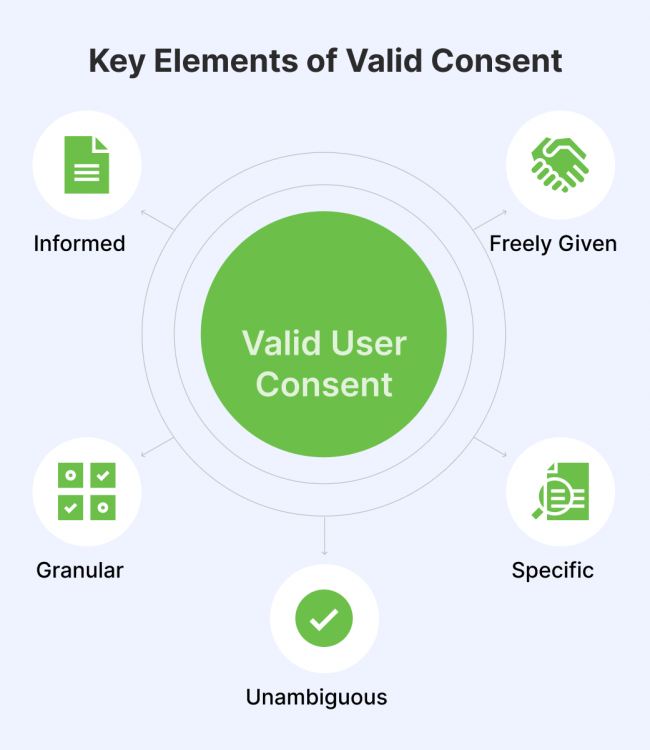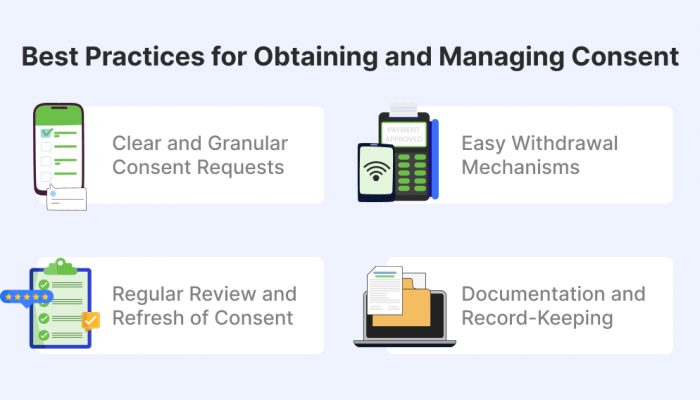As businesses continue to depend on personal data for growth, are you fully aware of how essential user consent is? Data collection is facing more scrutiny than ever, and not securing proper consent can lead to significant penalties and harm your reputation.
But what exactly is user consent, and why is it a cornerstone of data protection? This blog explores the significance of user consent in data processing, highlighting key regulatory frameworks.
Whether in tech, marketing, or compliance, understanding how to effectively manage user consent is essential for ensuring compliance, fostering trust, and avoiding costly mistakes in the digital age. Read on!
User consent refers to an individual’s permission to process their data. To be valid, consent must meet certain requirements set out by data protection laws.
Below are the key elements of valid consent:
So, valid consent is about ensuring transparency, choice, and control for users in their interactions with your business.

There are several types of consent that businesses should be familiar with, each with specific implications for data processing.
Below are the main forms of consent:
| Type of Consent | Description | Validity | Common Use Cases |
|---|---|---|---|
| Explicit | Clear, affirmative action. | Required for sensitive data | Health data, financial services, and sensitive personal information |
| Implied | Indicated through user actions. | Valid for non-sensitive data | Website cookies, tracking for analytics, and social media interactions |
| Opt-In | Active choice to participate in data processing. | Legally preferred globally | Email marketing, subscription services, personalized offers |
| Opt-Out | Automatically included unless consent is withdrawn. | Allowed for non-sensitive data (U.S.) | Marketing communications, email newsletters, and advertising |
Valid consent practices are essential for maintaining transparency and trust with your users. Here are a few examples of valid consent practices:
These examples help businesses respect users’ data rights and comply with regulations.
User consent is not just a regulatory requirement; it’s a critical component of building trust with your customers. By obtaining and managing consent properly, businesses can avoid significant penalties and improve their relationships with users.
User consent is a critical part of legal compliance, and failing to adhere to regulations can lead to severe consequences for businesses.
Here’s a look at how various laws address consent:
User consent plays a pivotal role in fostering trust and transparency. By clearly explaining how data will be used and providing users with control over their information, businesses demonstrate their commitment to privacy. This transparency not only helps ensure compliance but also strengthens relationships with customers, boosting brand loyalty.
Ethical considerations are at the heart of user consent. Respecting users’ privacy rights is essential in an era where data is increasingly commodified. Data collection without proper consent undermines user autonomy and can have significant ethical and reputational consequences for businesses.

Make sure that consent requests are clear, straightforward, and presented in plain language. Avoid legal jargon, and allow users to make informed decisions by offering granular options for different types of data processing.
Consent should be as easy to withdraw as it is to give. Implementing user-friendly withdrawal mechanisms, such as one-click unsubscribe options or easy-to-access consent management dashboards, ensures that users have full control over their data preferences.
As your data processing activities evolve, it’s essential to periodically reassess whether consent remains valid. Ensure that users are allowed to refresh their consent, particularly when new data practices are introduced.
Maintain thorough records of when, how, and for what purposes consent was obtained. Documenting consent ensures that your business can demonstrate compliance in the event of an audit or investigation.
Pre-ticked boxes and bundled consent violate the principles of user choice. To comply, users must be required to actively opt in to specific data processing activities rather than being automatically included.
Avoid using dark patterns that make it difficult for users to manage their consent. Consent mechanisms should be clear, visible, and easily accessible, ensuring users can make informed decisions without unnecessary obstacles.
Inadequate or misleading information about how data will be used is a common pitfall. Businesses must ensure that users fully understand what they are consenting to before submitting their data.
Getting user consent right isn’t just about ticking legal boxes, it’s about showing your customers that their privacy matters. When people feel in control of their data, they’re more likely to trust your brand and stick around. Clear, honest consent practices set the foundation for long-term relationships and reduce the risk of costly mistakes.
A trusted business is built on transparency and security. With Seers AI, you ensure that every user interaction is safe and compliant. Start today and show your users you respect their privacy.
Start Free TrialUser consent isn’t just a legal checkbox—it’s a critical factor in building customer trust. As regulations, such as GDPR and CCPA, continue to change, the lack of proper consent can cost you hefty fines and ruin your brand.
But beyond compliance, clear consent practices show users that you respect their privacy. This transparency strengthens customer loyalty, which directly impacts growth and retention in today’s data-driven market.
To be valid, consent must be freely given, specific, informed, and unambiguous. That means users need to clearly understand what they’re agreeing to and actively opt in. Pre-checked boxes or vague language won’t cut it.
Regulators in the EU and California are strict—if your consent methods aren’t up to standard, you risk serious penalties. Always offer users real choices and explain your data practices in plain language.
Opt-in means users must actively say “yes” before you collect or use their data, like ticking a box or clicking a button. Opt-out means they’re automatically included unless they take action to say “no.”
GDPR and most global laws prefer opt-in, especially for personal or sensitive data. Opt-out is still allowed in some U.S. contexts, but it’s less transparent and can erode trust if not handled carefully.
Consent rules differ by region, so one-size-fits-all won’t work. For example, GDPR requires explicit consent for most data use, while the U.S. often allows opt-out for certain cases.
Tools like consent management platforms (CMPs) help automate compliance across jurisdictions. They let users set preferences by region, purpose, and type of data, keeping you compliant and reducing legal risks wherever your users are based.
Failing to collect valid consent can have serious consequences, both legally and reputationally. Under GDPR, fines can reach €20 million or 4% of your global revenue. In the U.S., violations under CCPA can cost up to $7,500 per case.
Beyond fines, customers may lose trust, unsubscribe, or file complaints. Simply put, ignoring consent isn’t just risky—it’s bad for business
 Rimsha Zafar
Rimsha ZafarRimsha is a Senior Content Writer at Seers AI with over 5 years of experience in advanced technologies and AI-driven tools. Her expertise as a research analyst shapes clear, thoughtful insights into responsible data use, trust, and future-facing technologies.


United Kingdom
24 Holborn Viaduct
London, EC1A 2BN
Get our monthly newsletter with insightful blogs and industry news
By clicking “Subcribe” I agree Terms and Conditions

Seers Group © 2025 All Rights Reserved
Terms of use | Privacy policy | Cookie Policy | Sitemap | Do Not Sell or Share My Personal Information.